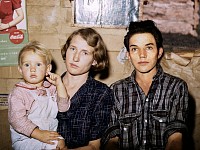BIOGRAPHY

1977-
Debbie Grossman is interested in playing with time, re-imagining history, and reviving archival images and documents. She received an MFA in Photography, Video, and Related Media from the School of Visual Arts, where she won the Paula Rhodes Memorial Prize, and holds a BA in Women’s Studies and Art History from Barnard College. She is also a Senior Editor at Popular Photography Magazine, where she is the resident expert on image editing software and technique. Her work is in the collection of the Metropolitan Museum of Art and the Jewish Museum, among others.
My Pie Town reworks and re-imagines a body of images originally photographed by Russell Lee for the United States Farm Security Administration in 1940. Using Photoshop to modify Lee's pictures, Grossman has created an imaginary, parallel world - a Pie Town populated exclusively by women. In some of Grossman’s revisions, she has taken male bodies and rendered them to look like masculine women; in others, she has taken pairs of women, shifted their distance and body language, and brought them closer to create a sense of intimacy. In some of the pictures Grossman has created women so masculine, or so ambiguously gendered, that they may not, for some viewers, clearly read as one gender or the other. She has also left a few images untouched, allowing for another dimension of re-reading Lee's work.
Because the images of Lee's time in Pie Town are available in high resolution form from the Library of Congress, Grossman was able to get close to Lee's images on a pixel level. Working with photographs and editing them so closely in Photoshop is a kind of an intimate act for the artist. Zooming in and carving a feminine jaw out of a masculine one, or manipulating the touch of one woman's hand on another's shoulder is a way for her to access and merge her desire with figures which would have otherwise remained frozen in time. This work creates something that reads as a photograph, and is infinitely reproducible like a photograph, but at the same time depends heavily upon the intervention of Grossman’s hand.
